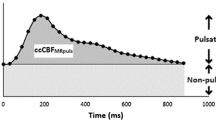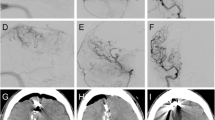Summary
The effects of craniotomy on cerebral haemodynamics remains controversial from a study of the literature. This report represents our experience with respect to CBF changes within 10 days of surgery. Our objective was twofold, first to study the effect of craniotomy on the cerebral circulation and second to determine wether the CBF pattern at different post-operative intervals could provide useful prognostic information. A total of 135 CBF measurements were performed at the bedside of 36 patients; 19 patients with an assortement of intracranial tumours and 17 patients with intracranial aneurysm in different clinical grades. Our results indicate a significant rise in CBF in the immediate post-operative period averaging 18% of the pre-operative value. We believe this reflects a normal reaction of the cerebral vasculature to the inevitable disturbance of surgery. Furthermore, this hyperaemia may be of prognostic value as it was observed in 85% of the patients with tumour discharged without post-operative deficit and in 80% of the patients with aneuryms discharged in clinical grade 1 or 2. This is in sharp contrast with its development in only 16% of the patients with tumour discharged with post-operative deficit and 16% of the patients with aneurysm discharged in grade 3 or 4. The study adds to the direct clinical utility of CBF determination as a prognostic tool.
Similar content being viewed by others
References
Agnoli, A., Prencipe, M., Priori, A. M.,et al., Measurements of rCBF by intravenous injection of133Xe: A comparative study with intra-arterial injection methods. In: Cerebral Blood Flow (Brock, M., Fieschi, C., Ingvar, D. H.,et al., eds.) Berlin-Heidelberg-New York: Springer 1969.
Austin, G., Horn, N., Rouke, S.,et al., Description and early results of an intravenous radioisotope technique for measuring regional cerbral blood flow in man. Europ. Neurol.8 (1972), 43–51.
Ferguson, G. G., Farrar, J. K., Meguro, K.,et al., Serial measurements of CBF as a guide to surgery in patients with ruptured intracranial aneurysm. J. Cereb. Blood Flow Metab.1 (Suppl. 1) (1981), S518-S519.
Géraud, G., Tremoulet, M., Guell, A.,et al., The prognostic value of noninvasive CBF measurement in subarachnoid hemorrhage. Stroke15 (1984), 301–305.
Høedt-Rasmussen, K., Skinhøj, E., In vivo measurements of the relative weights of gray and white matter in the human brain. Neurology16 (1966), 515–520.
Hunt, W. E., Hess, R. M., Surgical risk as related to time of intervention in the repair of intracranial aneurysms. J. Neurosurg.28 (1968), 14–20.
Ingvar, D. H., Lassen, N. A., Quantitative determination of regional cerebral blood flow in man. Lancet2 (1961), 806–807.
Kety, S. S., Schmidt, C. F., The determination of cerebral blood flow in man by the use of nitrous oxide in low concentrations. Amer. J. Physiol.143 (1945), 53–66.
Lovick, A. H. J., Pickard, J. D., Goddard, B. A., Prediction of late ischaemic complications after cerebral aneurysm surgery — use of a mobile microcomputer system for the measurement of pre-, intra-, and post-operative cerebral blood flow. Acta Neurochir (Wien)63 (1982), 37–42.
Mallett, B. L., Veall, N., Investigation of cerebral blood flow in hypertension using radioactive Xenon inhalation and extrcranial recording. Lancet2 (1963), 1081–1082.
Mallett, B. L., Veall, N., The measurment of regional cerebral clearance rates in man using Xenon-133 inhalation and extracranial recording. Clin. Sci.29 (1965), 179–191.
Merory, J., Thomas, D. J., Humphrey, P. R. D.,et al., Cerebral blood flow after surgery for recent SHA. J. Neurol. Neurosurg. Psychiat.43 (1980), 214–221.
Meyer, J. S., Effects of normal aging versus disease on cerebral vasomotor responsiveness. In: Cerebral Circulation and Neurotransmitters (Bes, A., Géraud, G., eds.), pp. 133–138. Amterdam-Oxford-Princeton: Excerpta Medica. 1980.
Nilsson, B. W., Cerebral blood flow in patients with subarachnoid haemorrhage studies with an intravenous isotope technique. Its clinical significance in the timing of surgery of cerebral arterial aneurysm. Acta Neurochir.7 (Wien) (1977), 3–48.
Nornes, H., Knutzen, H. B., Wikeby, P., Cerebral arterial blood flow and aneurysm surgery. Part 2: Induced hypotension and autoregulatory capacity. J. Neurosurg.47 (1977), 819–827.
Obrist, W. D., Thompson, H. K., Jr., King, C. H.,et al., Determination of regional cerebral blood flow by inhalation of 133-Xenon. Circ. Res.20 (1967), 124–135.
Obrist, W. D., Thompson, H. K., Jr., Wang, H. S.,et al., Regional cerebral blood flow estimated by Xenon-133 inhalation. Stroke6 (1975), 245–256.
Palmer, N. T., Thomas, D. J., MacGillivray, B. B.,et al., Variations in mean cerebral blood flow under anaesthesia at rest and during cortical activation. Stroke8 (1977), 269–271.
Risberg, J., Regional cerebral blood flow measurements by 133-Xenon inhalation: Methodology and applications in neuropsychology and psychiatry. Brain and Language9 (1980), 9–34.
Risberg, J., Ali, Z., Wilson, E. M.,et al., Regional cerebral blood flow by 133-Xenon inhalation. Stroke6 (1975), 142–148.
Rosenstein, J., Suzuki, M., Symon, L., Clinical use of a portable bedside cerebral blood flow machine in the management of aneurysmal subarachnoid haemorrhage. Neurosurgery15 (1984), 519–525.
Rosenstein, J., Wang, A., Symon, L.,et al., Relationship between hemispheric cerebral blood flow, central conduction time and clinical grade in aneurysmal subarachnoid haemorrhage. J. Neurosurg.62 (1985), 25–30.
Shinohara, Y., Takagi, S., Kobatake, K., Xenon-133 inhalation method: fetermination of normal CBF distribution and comparison with intravenous injection method. J. Cereb. Blood Flow Metab.1 (Suppl. 1) (1981), S106-S107.
Symon, L., Ackerman, R., Bull, J. W. D.,et al., The use of the Xenon clearance method in subarachnoid haemorrhage. Post-operative studies with clinical and angiographic correlation. Europ. Neurol.8 (1972), 8–14.
Thomas, D. J., Zilkha, E., Redmond, S.,et al., An intravenous 133 Xenon clearance technique for measuring cerebral blod flow. J. Neurol. Sci.40 (1979), 53–63.
Wang, A., Cone, J., Symon, L.,et al., Somatosensory evoked potential monitoring during management of aneurysmal subarachnoid haemorrhage. J. Neurosurg.60 (1984), 264–268.
Weir, B., Menon, D., Overton, T., Regional cerebral blood flow in patients with aneurysms: Estimation by Xenon 133 inhalation. Can. J. Neurol. Sci.5 (1978), 301–305.
Wollman, H., Alexander, S. C., Cohen, P. J.,et al., Two-compartment analysis of the blood flow in the human brain. Acta neurol. Scand. Suppl.14 (1965), 79–82.
Author information
Authors and Affiliations
Rights and permissions
About this article
Cite this article
Jabre, A., Symon, L., Richards, P.G. et al. Mean hemispheral cerebral blood flow changes after craniotomy. Significance and prognostic value. Acta neurochir 78, 13–20 (1985). https://doi.org/10.1007/BF01809235
Issue Date:
DOI: https://doi.org/10.1007/BF01809235




